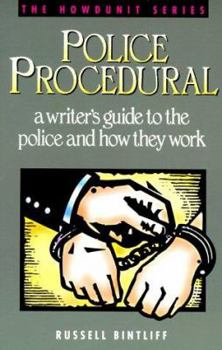Police Procedural: A Writer's Guide to the Police and How They Work
(Part of the Howdunit Series Series)
Select Format
Select Condition 
Book Overview
This book takes you inside not only police investigations, but also the day-to-day world of police work. You'll learn how police officers work, when they work, what they wear, who they report to, and... This description may be from another edition of this product.
Format:Paperback
Language:English
ISBN:0898795966
ISBN13:9780898795967
Release Date:January 1993
Publisher:Writer's Digest Books
Length:272 Pages
Weight:0.95 lbs.
Dimensions:0.8" x 6.0" x 9.0"
Customer Reviews
4 ratings
Another Great Howdunit!
Published by Thriftbooks.com User , 23 years ago
Police Procedural is really a "who does what" kind of book. It allows a writer to use the correct person or group to work a particular crime scene.Police Procedural explains the police services and uses a 'family tree' to display the order of command within the police department. Police Procedural also goes through the specific jobs such as bomb squad, homicide squad, etc. and it tells you what departments are responsible for certain crimes. It describes arrests and the procedures involved, interrogation, as well as the justice system.This book is basically a step by step guide of how the police work, how they file, train, what equipment they use, and even how law enforcement officers are selected. Police Procedural shows great pictures of search warrants, general affidavit, etc. Really helpful if you are presenting a document to your character.Overall this book is packed to the extreme with information...from who does it, what they do, and how they do it! The only down fault I found with this book is that I had trouble staying tuned in to read it in it's entirety, however it IS an excellent reference tool for the crime scene writer and should not be left out of your collection!
Another good one
Published by Thriftbooks.com User , 23 years ago
I have been using nearly all of the books in the Howdunit series. I am not primarily a crime writer but like being accurate on the little facts I do use when I include a crime or crime scene or police procedure in my books. I have found this book very helpful.
A useful reference, but not a fun read
Published by Thriftbooks.com User , 23 years ago
This is a good, solid, thorough information source about police departments and how they operate: it covers everything from how recruits are trained to the typical layout of a police station. It also has useful outlines of how various types of cases (homicide, burglary, etc.) are approached by investigators. And, once someone has been arrested, there's a helpful summary of the sequence of events involved in taking the case to trial and what the investigator's responsibilities are at each stage. (I consulted a friend who's a retired Assistant D.A., and her description of this process was very close to the book's, which I felt was a good recommendation!)Some cautions: 1. This is a "plain vanilla" description of police procedure. For specifics about a department's organization and facilities, whether it has specialists on staff (e.g., a fingerprint expert), and its training and promotion policies, you'll need to consult the actual police department. 2. Ditto for legal information. The definitions of crimes, the terminology used to describe them, the length of sentences, and other factors (e.g., "three strikes, you're out" laws) vary widely from state to state. Also, there may be differences in practice between what the criminal code says and the way it's normally applied, so talking to someone "in the know" is mandatory.Finally, I found the book VERY hard to read. The author clearly knows his stuff, and occasionally he deviates into an anecdote ... but he honed his writing style on police reports, so by and large the book is heavy going. I'm surprised that an editor didn't go through and, at least, break up some of his full-page paragraphs and shorten his longer sentences -- a lot could have been done with formatting and subheadings to make the book easier to use. Also, I felt that the index was barely adequate (no cross-references, for one thing), and the table of contents is very high-level too, so it took me a long time to find the specific piece of information I needed. I think this is a terrific reference book that should be in the library of every mystery writer -- but it definitely has flaws.
Excellant source for writers of suspense/mystery novels.
Published by Thriftbooks.com User , 25 years ago
This book should become part of every crime writers library. It describes in great detail the organization and investigative techniques of the police. It does become a little "text-bookish" in parts, but it covers a wide spectrum of police issues, investigating homicides, assault & battery and robbery, as well as vice(drug investigations and tips on arresting and interrogating suspects). It also includes a lengthy chapter on the officers testimony in court cases. Not a lot of information on sexual assault or missing persons cases but all in all it's a great book for writers.





